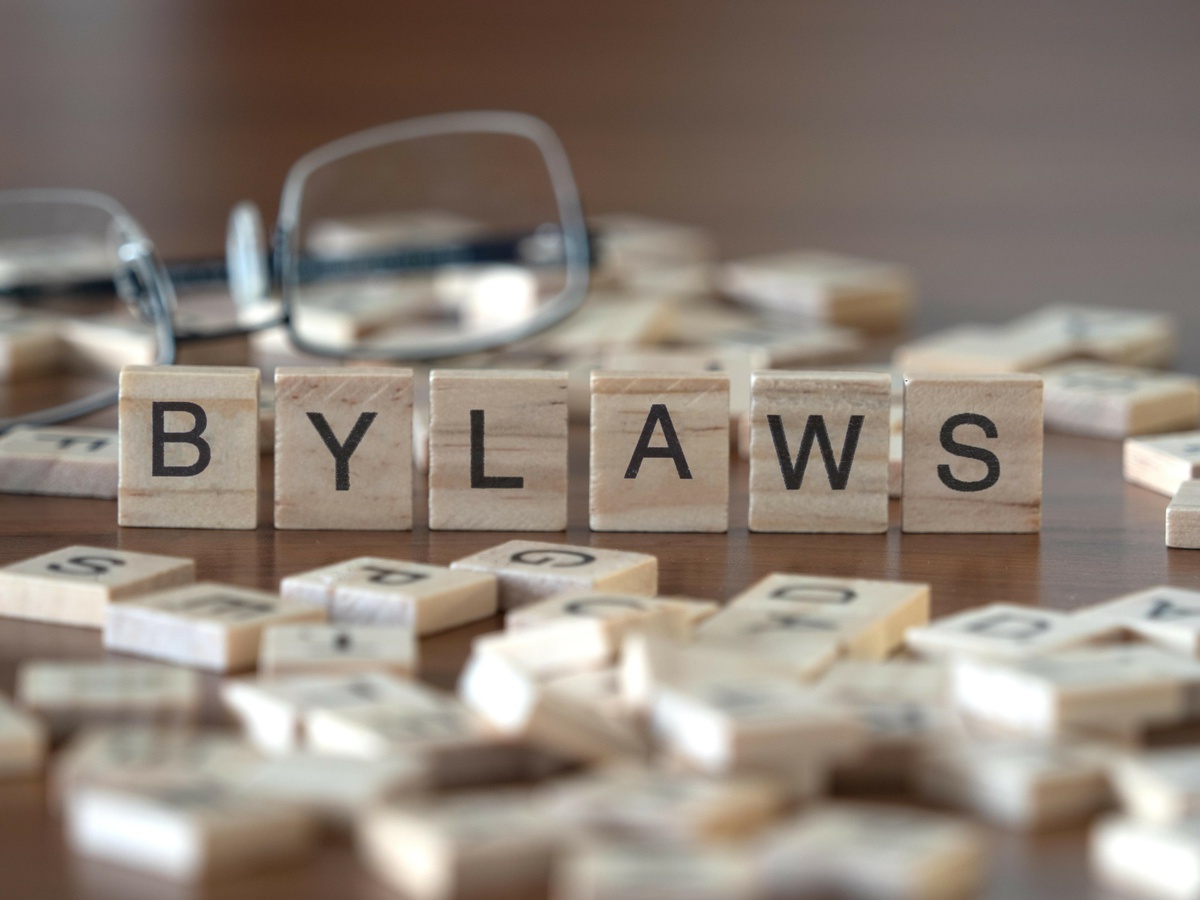 When you started your organization, you drafted a set of nonprofit bylaws which are the rules spelling out how your new venture would operate and how your Board would govern it.
When you started your organization, you drafted a set of nonprofit bylaws which are the rules spelling out how your new venture would operate and how your Board would govern it.
Now, you are not so new anymore. Maybe you just celebrated your nonprofit’s second or third birthday. Or maybe your nonprofit has been around for years. Either way, you may find that the bylaws you created before you started raising money and running programs are probably outdated.
That’s the thing about your first set of bylaws: they lose relevance as soon as your organization is off and running, like a new car depreciating as soon as you drive it off the lot. Why?
Many new organizations draft bylaws based on a template or an existing organization’s bylaws. In those early days, you’re just trying to get off the ground. It seems like a shortcut to replace another organization’s name with yours and … voila! Those are now your bylaws.
The truth is, when you’re getting started, you have a vision for how things will go, but you don’t really know until you get rolling. And once you begin operations, so many things are different than you expected.
You may find you need more Board members than the max of 8 as defined in your bylaws. You might find you need to meet monthly instead of quarterly. Simply put, you don’t know what kind of governance rules your nonprofit needs until you are actually operating.
Like so much of nonprofit life, it’s learn as you go.
And the day comes when you realize your nonprofit bylaws are out of date.
How Do I Know If My Nonprofit Bylaws Need a Refresh?
Start by reviewing your bylaws.
When was the last time you even read them? Be honest! Has your Board chair read the bylaws recently? Have Board members read them lately?
Read through each bylaw and ask yourself whether it still applies. You may find that your Board has gotten into a routine of doing things that work for them that are out of sync with your bylaws. This is normal as Boards find their groove and get used to working together.
You may be tempted to just change your bylaws to reflect how the Board is currently operating, but you shouldn’t do that. Think about how you want your organization to function and adjust the bylaws accordingly. What you want and what you have right now may be different.
When you do change the bylaws, there’s more to it than simply updating a document. There is a formal process to follow to change bylaws for nonprofit organizations. The process is not difficult and when you finish you will feel great knowing your bylaws are current and serving their purpose.
Why Is It Important to Update my Nonprofit Bylaws?
If your bylaws do not represent how your Board currently operates, you are at risk of a lawsuit! Is that reason enough?
Bylaws are not guidelines, recommendations, or suggestions. Your bylaws are your rules and they are legally binding.
The good news is that YOU get to set these rules. The bad news is that you’re obligated to follow them. And if you’ve deviated from them, you need to either get back in compliance with them or amend them, following a formal process.
It is highly unlikely that a donor, employee, or other stakeholder would sue the Board over failure to follow its bylaws. But, it is not a risk worth taking. Make reviewing and updating your bylaws something you do as a matter of routine every three years so you can ensure they’re current.
What Should Be Included in Nonprofit Bylaws?
 Your bylaws should not be overly long or complex. The focus should be on governance. Keep them high level, without getting into the weeds of day-to-day operations.
Your bylaws should not be overly long or complex. The focus should be on governance. Keep them high level, without getting into the weeds of day-to-day operations.
Here are the issues your bylaws should address:
- The organization’s purpose: Broadly speaking, what does your organization do? If you include your mission statement and your mission statement changes, as they often do, you need to update your bylaws. A more general statement will have more staying power. For example: “The organization’s purpose is to fight hunger in our community.”
- The organization’s activities: What types of programs does your organization offer? You do not need to be specific. Just generally describe what your organization does to address a community need. “We provide food through our food pantry and also via a mobile service.”
- Activities the organization does NOT engage in: This is where organizations typically state that they don’t engage in political campaigns or other activities that fall outside a typical nonprofit. You can also use this space to note activities may be assumed to be in your organization’s purview, but that are out of scope.
- The Board: Here’s where you address all things related to the Board. How and when are Board members elected? What are the qualifications to serve? What is the minimum and maximum number of Board members allowed? How long are terms and what is the maximum number of terms members can serve?
How can Board members be dismissed and for what offenses? This is where organizations address chronic absenteeism, which is, unfortunately, an issue most Boards face.
- Board officers: Which officer positions does the Board have? Most have Chair, Vice Chair, Secretary, and Treasurer. How and when are officers elected? How long are their terms?
- Board meetings: How and when are Board meetings held? Who can call a Board meeting? What is the procedure to do so?
- Action outside of Board meetings: Most Boards need to occasionally conduct routine business via email. What is the procedure for that?
- Board committees: Which standing committees does the Board have? Many Boards have a Steering or Executive Committee, a Finance Committee, and a Governance Committee, which oversees Board recruitment and makes sure the Board operates according to the bylaws.
Other committees may include Fundraising, Communications, and Community Outreach. But … you don’t have to list in your bylaws every committee you may have. Just stick to the ones that are essential for governance and include language like “Other committees will be formed as needed.” Remember, if you put too much in your bylaws, you will need to spend more time updating and changing them.
- Organization finances: When does the organization’s fiscal year begin and end? When does the Board adopt an annual budget?
- Organization documents: What documents will the organization maintain? Where will documents be stored?
In addition to a cloud storage solution, such as Box or Dropbox, I recommend printing out a hard copy of your bylaws and storing them in a locked drawer or safe with your articles of incorporation and other important documents. Make sure you and the Board chair have a key or combination, and put a third key in a secure location and tell several people where that is.
- Dissolution of the organization: Organizations cease operations for a variety of reasons. The need to close may be because the organization is no longer needed because the problem the organization works to solve gets addressed. Wouldn’t that be great?
Not having enough committed people to operate the organization or not being able to consistently raise the money needed to run programs are common reasons for dissolution. It is important that your bylaws provide the Board with direction on how to handle what can be a painful task.
If you think your current bylaws are seriously lacking, ask peer organizations to share their bylaws for comparison. But resist the temptation to just copy another organization’s bylaws. You can also find templates for nonprofit bylaws and nonprofit bylaws samples online, if you feel like your refresh will be more of a rewrite.
What’s the Process to Update Your Bylaws?
Reviewing and updating your bylaws is not a long or difficult process but it is an important one.
It can be hard to make this important task a priority when you are focused on the day-to-day activities of fundraising and building programs. Reviewing bylaws may not feel as urgent, but you should carve out a little time to take these simple steps.
Step #1: Review what’s required of your nonprofit bylaws: Here in the U.S., your first step in reviewing and updating your bylaws is to research what your state requires. Make notes of any requirements outlined for what your bylaws should include and any instructions provided for updating bylaws.
Now, you know more about what your bylaws need and don’t need. You are in a better position to recommend to your Board bylaws that reflect your organization’s needs.
Step #2: Assemble a committee to review the current bylaws: Enlist two or three Board members to serve on a Bylaws Review Committee. This process should only involve a couple of meetings, so it isn’t a heavy lift.
Step #3: Comb through your current bylaws and highlight areas that need attention: Go through each section and reflect on whether the Board is currently following it and whether it needs to be changed. If your bylaws are unnecessarily detailed, you may need to delete some language.
Step #4: Convene the committee and discuss highlighted items. Consider consulting a qualified attorney if there are some sticky or confusing issues to resolve. Think about what you need to change to make your bylaws consistent with current Board practices and to make sure they will serve your organization well long-term.
Step #5: Revise the bylaws with proposed language. Revise your bylaws with the committee. Make any revisions based on feedback from committee members. Try to get to a draft that everyone on the committee agrees with.
Step #6: Introduce the newly revised bylaws at a Board meeting. Share with the full Board the proposed changes. Open the floor for discussion. Don’t be surprised if Board members are not super engaged with this agenda item. Bylaws are important, but not typically regarded as fascinating.
Follow your bylaws, if you have a process spelled to change the bylaws in your bylaws. If you do not, follow Roberts Rules of Order and call for a vote. Your chances of getting the required majority are excellent!
Well done! You have taken the time to review and revise your bylaws. Archive the original bylaws to avoid confusion.
Note on the new bylaws the date in which they were adopted. The new bylaws should be stored in your cloud storage, and a paper copy should be stored with other important documents, in accordance with your bylaws.
And be sure to send a copy of your new bylaws to any state or other government agencies that require it (your earlier research should have revealed that).
The Bottom Line
 Your bylaws are your rule book for governing your nonprofit. And, they’re legally binding. In short, they’re important! Yet we often treat them like an afterthought, something we want to take care of as quickly as possible, often borrowing language from another organization.
Your bylaws are your rule book for governing your nonprofit. And, they’re legally binding. In short, they’re important! Yet we often treat them like an afterthought, something we want to take care of as quickly as possible, often borrowing language from another organization.
Take a break from Fundraising 101 to get your nonprofit house in order, starting with your bylaws. Review them. Revise them. Make sure they aren’t so specific and detailed that they hem you in or require you to revise them constantly.
Create bylaws that tell your Board how to govern this beautiful and needed nonprofit organization! With this road map, your organization will be a lot less likely to end up in a ditch!
With solid bylaws and committed Board members, you can build a stable, successful organization, one that makes a difference in the community and changes more lives. And that’s what it’s all about!






Is it a good practice to post bylaws on a nonprofit’s website?
What other information should be posted there for good transparency?
I don’t think I’d post the bylaws on the website, but you definitely want to share your latest financial information. Here in the US, share your form 990 at a minimum.